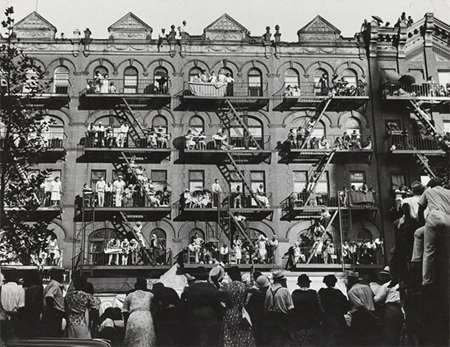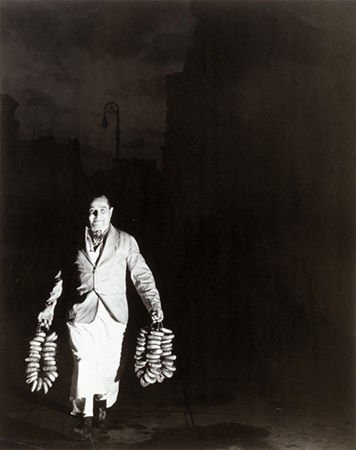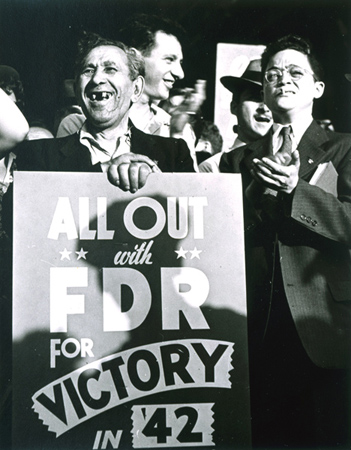
“The Radical Camera” Remembers the Pre-McCarthyism Doc Era
The Radical Camera: New York’s Photo-League 1936-1951 remembers a 15-year period in New York in which Harlem, communist worker parades, Coney Island, and kids jumping off buildings to cool down in the Hudson River, made photography a tool of self-discovery in many of New York’s until-then unseen neighborhoods. Long before Budd Schulberg and Marlon Brando spotlit the working man’s life in the movies, this was an era when a documentary eye and a hyperrealist if poetic sensibility informed a coalescing excellence among a peer group who challenged each other to bring back the goods to the League.
While the show closed March 25th its interactive map, and a blog amplifying on some of the pictures and photographers, continue accessible.

Max Rushing the Bagels.., Weegee, at the Radical Camera
Click for instance on “lower east side” and you have Rebecca Lepkoff’s eponymous “Lower East Side” (1947) in which a boy carries a tire past a wall pasted with a poster for Gentlemen’s Agreement. Weegee’s “Max Rushing In the Bagels to a Restaurant on Second Avenue for the Morning Trade ” (1940) has a smiling Max appearing out of the dark on 14th and Avenue C, wearing light-colored pants and carrying in both hands bagel-strung necklaces.
The Photo League organized “photo hunts” and the “Crazy Camera Ball.” Leaguers including would chase a theme around New York for a day:” “The Law,” “Bring Me Wine,” then rush back to the League with film; everybody would get a spaghetti dinner and possibly a performance by the likes of Pete Seeger.
As geography the map is indeed quite the document; all the locations, believe me, have profoundly changed.
Demonstrating the impact of images in the pre-McCarthy era, the politics of the Leaguers eventually caused them grief , after the League was blacklisted by the Attorney General in December 1947.
1948 chronicles of protests like “May Day, Fight for Peace”, names images that both N. Jay Jaffee and Jerome Liebling produced. George Gilbert’s work remembers a part of the re-elect FDR movement that urged the president to support the Soviet Union.
If it’s too much stereotyping to say a New York labor sensibility also flowered in leisure time at places like Coney Island, a summer day inspired Morris Engel’s terrific Women on the Beach (1938) in which the then 20 year old photographer lay on his back on the sand and turned his lens upward to the “frieze” shot of one woman’s backside and two others kanoodling at each other.
Engel’s1953 film, The Little Fugitive, also shot at Coney Island, about a 7 year old runaway to the beach for a day, influenced Francois Truffaut.
Aaron Siskind was part of the Photo-League. One of the superb photographs co-opted to another of the era’s political agendas was Jack Manning’s “Elks Parade”, in which both the street (128th Street) and the tenement fire escapes are crowded with watchers of the parade on a day in the late 1930s. Professor Maurice Berger is quoted at this link on how the image came to be colonized for a politics against the Harlem neighborhood where the picture was taken.

A rally for FDR, George Gilbert, at The Radical Camera
In a disturbing epilogue, Sid Grossman whom we learn had been an early articulator of framing beyond subjectivity in the documentary image, having been “particularly victimized and disillusioned by the blacklist”, took to Provincetown, Mass. where his studies of raptors at oceanside look eerily prescient and symbolist, even though they were said to be his homage in photography to abstract expressionist painting.
